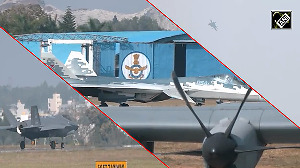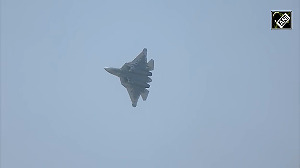There are many reasons related to the physics and engineering of nuclear bombs or warheads that necessitate a full testing programme for each weapon design. There are still more reasons related to the concept, strategy and psychology of deterrence that also necessitate continued nuclear testing.
There are plenty of reports in America that attest to the importance of weapons designs undergoing full testing programmes before they are given to the military for induction.
In 1987, for instance, an American committee set out to rubbish an earlier report that had said nuclear testing was necessary to maintain nuclear weapons. The second report actually ended up concluding that: 'Most of the reliability problems in the past have resulted from either an incomplete testing program during the development phase of a weapon or the aging and deterioration of weapon components during deployment'.
The Indo-US nuclear deal | The nuclear deal chats
Robert Joseph, the current Under Secretary of State for Arms Control, who has insisted that India should undertake not to conduct any further nuclear tests in exchange for civil nuclear cooperation, had concluded in a 1998 study that 'retaining the safety, reliability, and performance of the nuclear weapons stockpile in the absence of underground nuclear testing is the highest-risk component of the US strategy for sustaining deterrence'.
If these reports from a nation that has conducted over a thousand nuclear tests, and built and deployed thousands of nuclear weapons over the last six decades, are not enough to make the Manmohan Singh government give some more thought to the 'no more nuclear tests' diktat of the Hyde Act, consider what a former nuclear weapons testing expert has said.
Some years ago, Theodore Taylor, a former nuclear weapons testing expert at the Lawrence Livermoore Nuclear Laboratory explained the necessity of thoroughly testing different types of nuclear weapons.
According to Taylor, zero-yield testing would suffice to give confidence that simple fission weapons would work. Such tests can be done 'by producing a fission yield high enough to be observable with radiation detectors placed close to the weapon, but still equivalent to less than 1 gram of high explosive'. To be confident about boosted fission weapons, however, 'these have to be tested at full or close to full yield'.
Says Taylor: ' there is some minimum threshold yield below which tests of boosting are not possible Deviations from idealized, calculated performance along with the considerable complexity of the boosting process itself -- involving important feedbacks between fission and fusion as the explosion proceeds -- tend to make it necessary to test boosted weapons at full yield if they are to be put into weapons stockpiles
'How well boosting will work in a weapon of a particular design cannot be determined with high confidence by calculations, laboratory tests, or very low yield nuclear tests Data from past nuclear tests incorporating boosting can help considerably in predicting the performance of new types of boosted weapons. Without prior experience of this kind, however, weapon developers would need to test boosted weapons to be confident of their performance'.
About thermonuclear weapons, 'It is difficult to imagine confident stockpiling of thermonuclear weapons by a country that has never tested any with yields substantially larger than the yields of their fission triggers... thermonuclear weapons are substantially more complex and subject to performance uncertainties than fission weapons. Confident development of thermonuclear weapons is therefore likely to require nuclear tests with yields greater than a quarter or so of the full design yield'.
Accepting Taylor's wisdom, we must conclude that to be able to build 100 KT boosted fission weapons and confidently induct them into the arsenal, India would have to test such a device at close to that yield at least once. To be able to build 200-500 KT warheads a capability claimed by India it would have to test a thermonuclear device at 50-125 KT yield at least once. India has done neither until now.
There is yet another crucial consideration for India. Suppose it continues to observe its not-so-voluntary moratorium on testing for the next two decades, as it did between 1974 and 1998. At a later date, it is likely to find itself unable to conduct nuclear tests even if it wanted to or to make nuclear weapons of new designs.
That's because, as Professors Donald MacKenzie and Graham Spinardi of the University of Edinburgh found out, making nuclear weapons involves a lot of tacit knowledge that is innate to those working, say, on a lump of plutonium which has to be machined into a very precise shape and size for every particular equation of state.
Such expertise and experience were available to India in 1998 even after a gap of 24 years because many of the scientists, engineers, technologists and machinists who were involved with the 1974 test were still around in 1998. But ten or twenty years from now, they won't be, and in all likelihood all that tacit knowledge which is non-transferrable -- will be gone with them. And the Indian nuclear weapons programme will have to start from scratch again.
Given these realities, the Indian claims of not needing any more nuclear tests and its continued observance of its voluntary moratorium seem silly. No wonder the world refuses to regard India as a nuclear weapons power.
It is time to put an end to our jingoism and silly claims and to prove our deterrent capability. As someone said, ''deterrence, like beauty, lies in the eye of the beholder''. And if the beholder cannot see a well-tested 100 KT warhead, he is unlikely to be deterred for long.
Next: By waiting, India loses
Earlier in this series:






 © 2025
© 2025